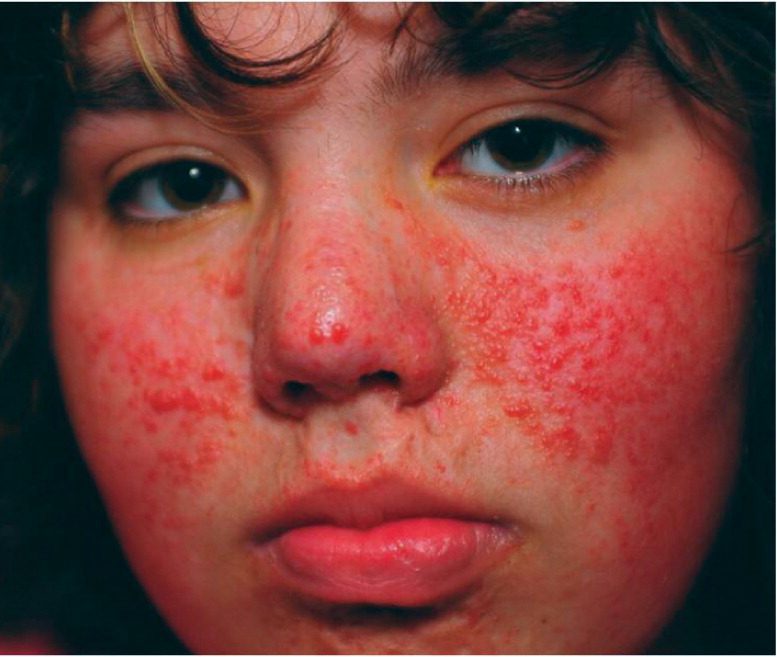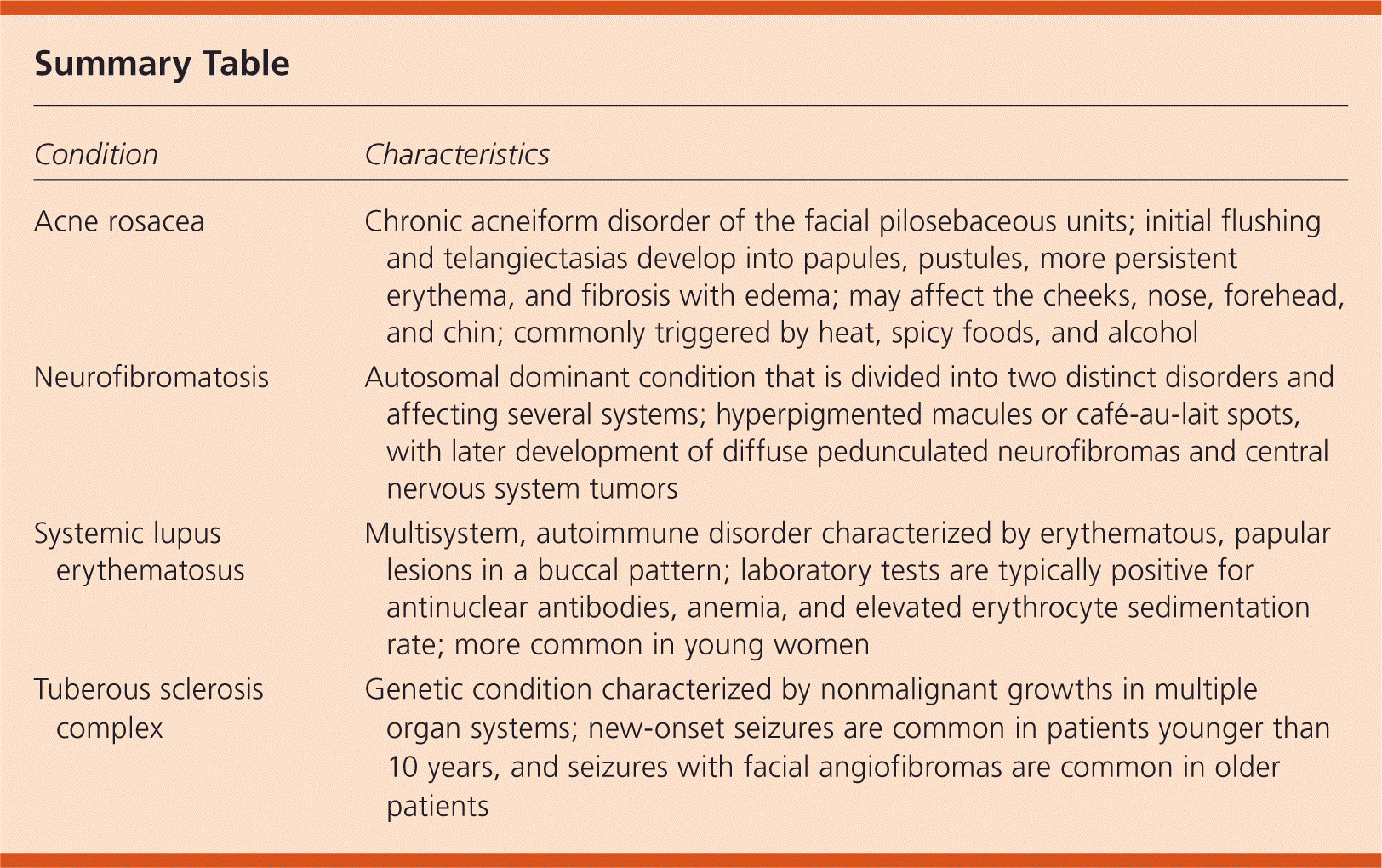
Am Fam Physician. 2012;86(11):1065-1067
Author disclosure: No relevant financial affiliations to disclose.
A 19-year-old woman presented with a red rash on her face. The nonpainful bumps had been present for several years and had been unsuccessfully treated with topical retinoids and laser therapy. The patient had a history of seizure disorder and mental retardation.
The examination revealed multiple erythematous papules coalescing into plaques around the buccal area of the patient's face (see accompanying figure). She had mild erythema on her cheeks, forehead, and nasolabial folds. Her face was not warm to palpation, and she did not have open or closed comedones. A 3-mm punch biopsy of the erythematous area showed proliferation of fibrous tissue and perifollicular concentric fibrosis.

Question
Discussion
The answer is D: tuberous sclerosis complex. Tuberous sclerosis complex is a genetic condition characterized by nonmalignant growths in multiple organ systems. Most patients with the condition will develop a hypopigmented macule or ash leaf spot on their skin, which can be 1 to 12 cm in size by one year of age. About 80 percent of patients will develop facial angiofibromas. By two years of age, 50 percent of patients will have a leathery skin-colored plaque (shagreen patch).1 The angiofibromas are composed of a dermal proliferation of fibroblasts arranged around hair follicles and blood vessels.
Tuberous sclerosis complex occurs in approximately one or two in 10,000 live births.2,3 All of the clinical features of the disease may not be evident in the first two years of life. New-onset seizures are the most common presenting symptom in patients younger than 10 years, whereas seizures with facial angiofibromas are most common in older patients.4
The diagnostic criteria for tuberous sclerosis complex include several major and minor clinical features.5 This patient had three major criteria: facial angiofibromas, hypomelanotic macules, and a shagreen patch. Genetic testing may be used to confirm the diagnosis.
No treatment is required for the angiofibromas because they are not precancerous. However, if treatment is desired for cosmetic reasons, dermabrasion and laser therapy may be effective. Treatment of the disease itself should involve a multidisciplinary team of family physicians, ophthalmologists, neurologists, and dermatologists. Neurologic complications from brain tumors and seizures are the most common cause of death from tuberous sclerosis complex, followed by renal disease.6 Despite treatment, 30 percent of patients with severe cases will die before five years of age, and up to 75 percent will die before reaching adulthood.7
Acne rosacea is a chronic acneiform disorder of the facial pilosebaceous units that is common in middle-aged adults. Rosacea usually starts with mild symptoms of flushing and telangiectasias that later develop into more persistent erythema, leading to papules, pustules, and eventually fibrosis with edema. The lesions can affect the cheeks, nose, forehead, and chin.7 Common triggers include heat, spicy foods, and alcohol.
Neurofibromatosis is a neurocutaneous autosomal dominant condition that is divided into two distinct disorders (neurofibromatosis 1 and 2) and affects several systems. In both conditions, patients develop hyperpigmented macules or café-au-lait spots during the first few years of life, and later develop diffuse pedunculated neurofibromas and central nervous system tumors. Bilateral acoustic neuromas are features of neurofibromatosis 2, whereas pigmented hamartomas of the iris (Lisch nodules) and pheochromocytomas are features of neurofibromatosis 1. Diagnosis is based on clinical criteria and a family history of the condition.7
Systemic lupus erythematosus is a multisystem, autoimmune disorder characterized by erythematous, papular lesions in a buccal pattern. It often affects young women, who are usually diagnosed in their 30s or 40s. The clinical course varies significantly. Laboratory tests may be positive for antinuclear antibodies (e.g., anti-dsDNA antibodies), anemia, and an elevated erythrocyte sedimentation rate.

| Condition | Characteristics |
|---|---|
| Acne rosacea | Chronic acneiform disorder of the facial pilosebaceous units; initial flushing and telangiectasias develop into papules, pustules, more persistent erythema, and fibrosis with edema; may affect the cheeks, nose, forehead, and chin; commonly triggered by heat, spicy foods, and alcohol |
| Neurofibromatosis | Autosomal dominant condition that is divided into two distinct disorders and affecting several systems; hyperpigmented macules or café-au-lait spots, with later development of diffuse pedunculated neurofibromas and central nervous system tumors |
| Systemic lupus erythematosus | Multisystem, autoimmune disorder characterized by erythematous, papular lesions in a buccal pattern; laboratory tests are typically positive for antinuclear antibodies, anemia, and elevated erythrocyte sedimentation rate; more common in young women |
| Tuberous sclerosis complex | Genetic condition characterized by nonmalignant growths in multiple organ systems; new-onset seizures are common in patients younger than 10 years, and seizures with facial angiofibromas are common in older patients |
